
 |
|
Ceres
~ Small Dwarf Planet - Asteroid Belt
Ceres, minor-planet designation 1 Ceres, is the largest asteroid and the only dwarf planet in the inner Solar System. It is a rock–ice body 950 km (590 mi) in diameter and the smallest identified dwarf planet. It contains about one-third of the mass of the asteroid belt. Discovered on 1 January 1801 by Giuseppe Piazzi, it was the first asteroid to be identified, though it was classified as a planet at the time. It is named after Ceres, the Roman goddess of growing plants, the harvest, and motherly love. The Cererian surface is probably a mixture of water ice and various hydrated minerals such as carbonates and clays. It appears to be differentiated into a rocky core and icy mantle, and may harbor an ocean of liquid water under its surface. From Earth, the apparent magnitude of Ceres ranges from 6.7 to 9.3, and hence even at its brightest it is still too dim to be seen with the naked eye except under extremely dark skies. The unmanned Dawn spacecraft, launched on 27 September 2007 by NASA, is expected to be the first to explore Ceres after its scheduled arrival there in 2015. After having orbited asteroid 4 Vesta since July 2011, the spacecraft departed about 5 September 2012. 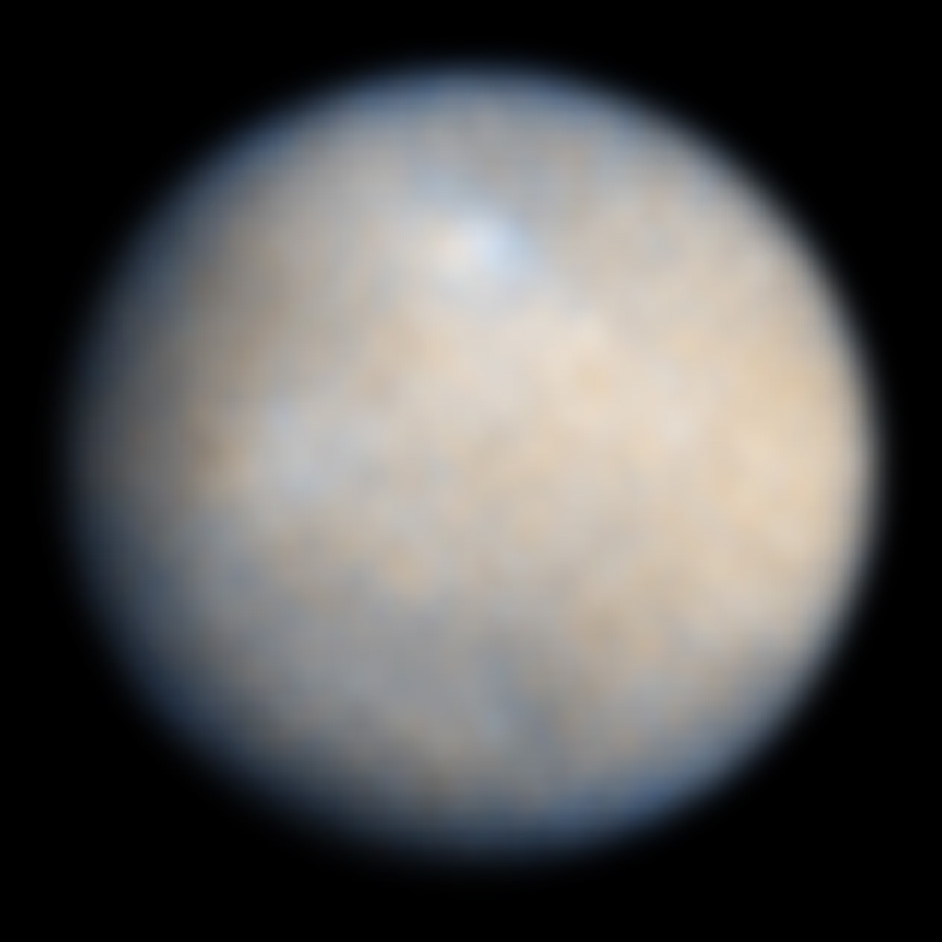 NOTE TO STAFF: MAPPING NIGHTMARE... NEED MORE DATA 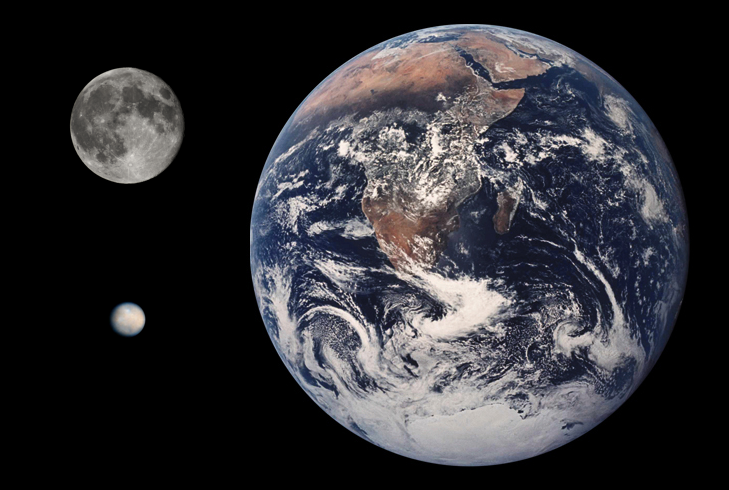 Size
Comparison to Earth and Moon.
Courtesy: NASA
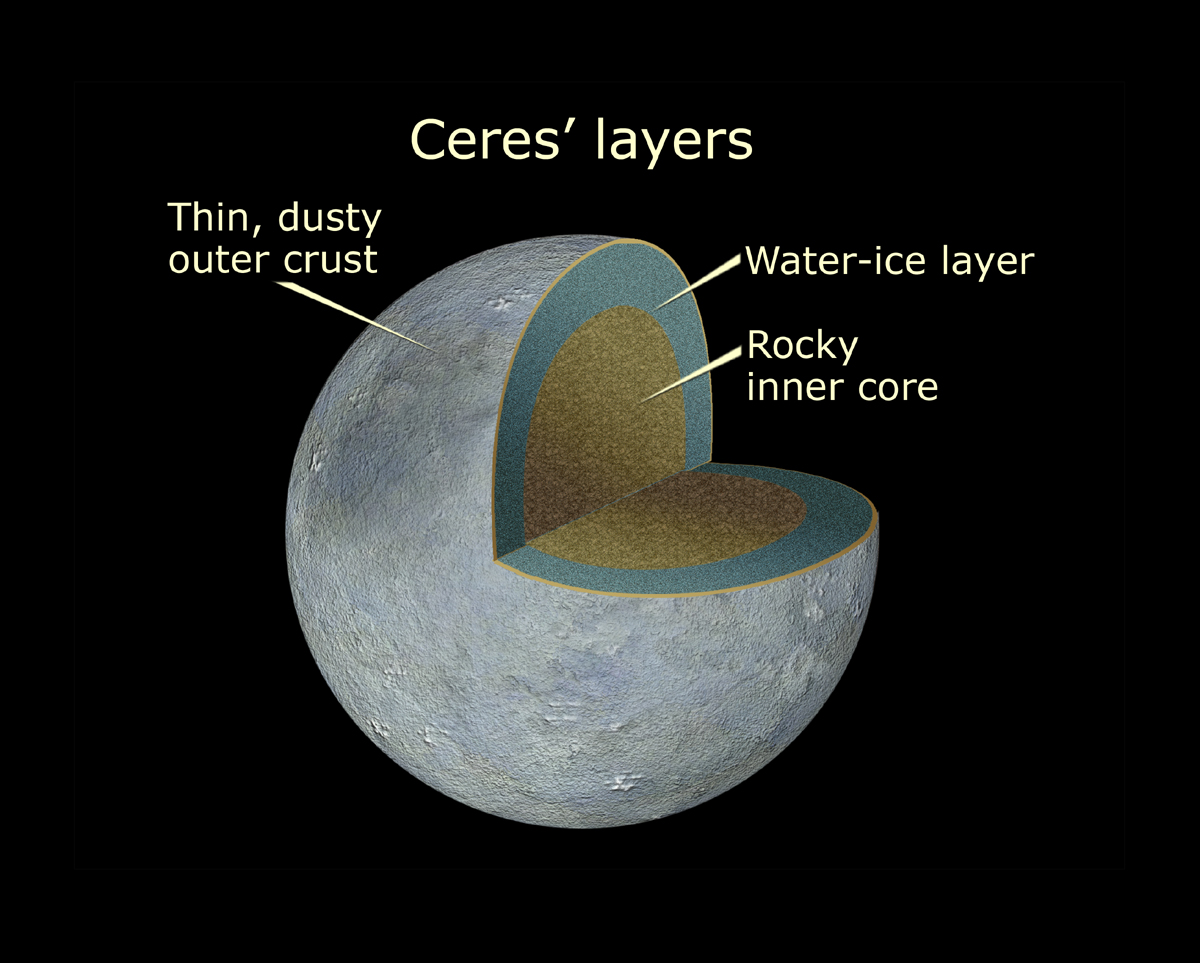 Cutaway view of asteroid 1
Ceres. Observations of 1 Ceres, the largest known
asteroid, have revealed that the object may be a
"mini planet," and may contain large amounts of
pure water ice beneath its surface. The
observations by NASA's Hubble Space Telescope also
show that Ceres shares characteristics of the
rocky, terrestrial planets like Earth. Ceres'
shape is almost round like Earth's, suggesting
that the asteroid may have a "differentiated
interior," with a rocky inner core and a thin,
dusty outer crust.. Courtesy: NASA Hubble
|
Ceres ~ Small Dwarf
Planet - Asteroid Belt Discovered:
January 1,1801 by Giuseppe Piazzi of Italy (first
asteroid/dwarf planet discovered) Discovered:
January 1,1801 by Giuseppe Piazzi of Italy (first
asteroid/dwarf planet discovered)
Astronomers estimate that if Ceres were composed of 25 percent water, it may have more water than all the fresh water on Earth. Ceres' water, unlike Earth's, is expected to be in the form of water ice located in its mantle. Courtesy NASA: Dawn's Targets - Vesta and Ceres |
| Images of Dwarf Planet Ceres Press Release Source: W.M. Keck Observatory Although Ceres is the largest main-belt asteroid and was the first to be discovered (by G. Piazzi in 1801), its physical properties are still not well understood. While it is expected to have retained a large amount of primordial water ice in its interior, many questions about the composition of its surface and sub-surface layers, the properties of its regolith and its degree of differentiation, remain unanswered. 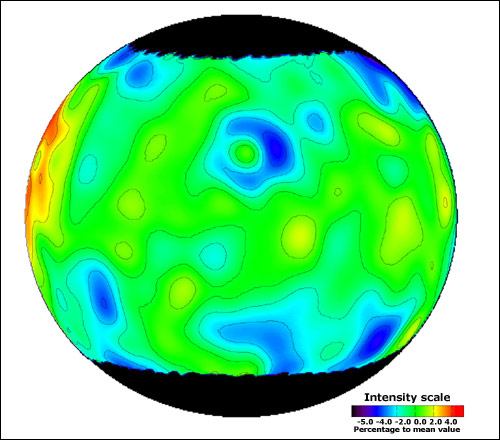 Credit:
LESIA\ESO\SwRI\W. M. Keck Observatory
Infrared images of
Ceres reveal a textured surface, and
astronomers have produced a colour 3D
model from the data. The blue in the
3D model corresponds to the dark
patches in the infrared, the yellow to
the bright. The blackout at the edges
is due to insufficient data at the
poles.A team of astronomers led by Benoit Carry of the Paris-Meudon Observatory used state-of-the-art adaptive optics instrumentation available at the Keck observatory, Mauna Kea, Hawaii, to image the surface of Ceres with a spatial resolution of ~30km. The observations were carried out during the September 2002 opposition of Ceres in the near-infrared J/H/K-bands, at a wavelength range particularly well adapted to investigate the composition and properties of planetary surfaces. The team produced albedo maps covering 80 percent of the asteroid, which appears to display a wealth of 40 to 160km large geological features with intensity in reflected light varying by ~12 percent across the surface. The team suggests that the variations could be due to terrain features, as well as differences in their surface composition and/or degree of alteration by space weathering effects (such as aging of surface due to interaction of solar wind, micrometeorites impacts, etc). The team also derived measurements of the dimension and shape of the dwarf planet Ceres, which can be considered as an oblate spheroid of radii a=481km and b=447km (incertitude of +/-14 km). The direction of its spin axis in a J2000 coordinate referential is right ascension=287 degrees and declination=69 degrees (5 degrees of incertitude). These two results are in agreements with earlier reports made by Thomas et al. (Nature 2005) from the analysis of Hubble Space Telescope observations. Additional spatially resolved spectroscopic observations are needed to investigate further the properties of Ceres surface. Such programs will help in the preparation of the NASA DAWN mission, which will reach Ceres in 2015 and explore, from orbit, the properties of this intriguing solar system body. The team is currently planning complementary observations of Ceres during its next opposition in November 2007, using a suite of adaptive optics instruments at the Very Large Telescope of the European Southern Observatory in Chili. 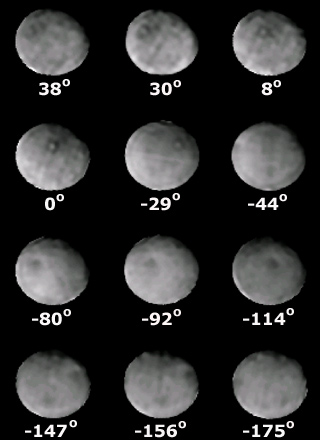 Credit:
LESIA\ESO\SwRI\W. M. Keck Observatory
360 images from the NIRC2 camera on Keck II were used to produce this infrared image of Ceres. Media Contact: Laura K. Kinoshita |
| See Also: Water Detected on Dwarf
Planet Ceres |
Papers,
Links, Etc:
|
|
All material on these pages, unless otherwise noted, is © Pegasus Research Consortium 2001-2019 |
 Webpages © 2001-2019 Pegasus Research Consortium |